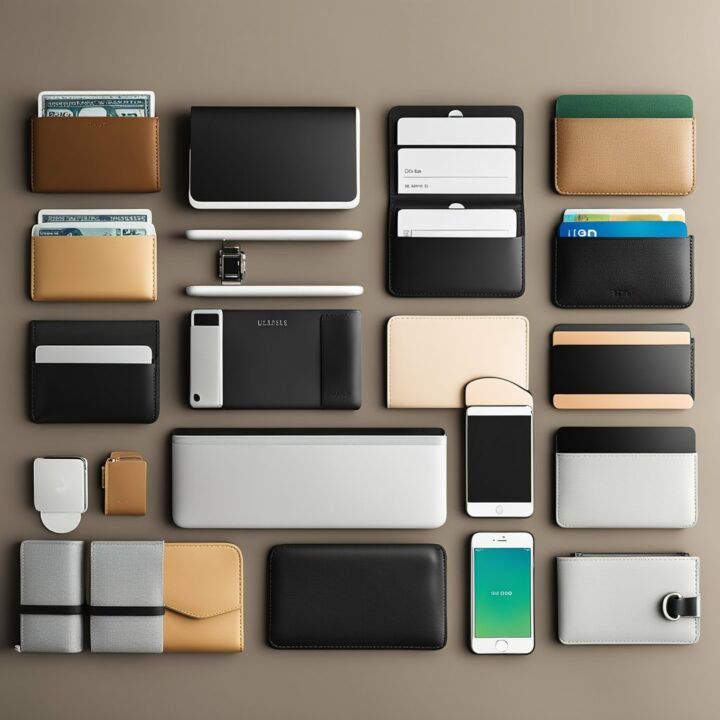Are you tired of carrying around a bulky wallet that takes up too much space in your pocket? Look no further, as this step-by-step guide will show you how to save space with a minimalist wallet. With empathy, I understand the frustration of dealing with an overloaded wallet, which is why I’m here to help. By following these simple steps, you’ll not only declutter your pocket but also streamline your daily life. Say goodbye to unnecessary bulk and hello to a more minimalist and streamlined wallet experience.
Choosing the Right Wallet
When choosing the right minimalist wallet, there are a few factors to consider. First, think about the size of the wallet that will best suit your needs. If you only carry a few cards and some cash, a smaller, more compact wallet will likely be sufficient. On the other hand, if you need to carry multiple cards, IDs, and other items, a larger wallet with more compartments may be necessary.
Next, consider the material of the wallet. Common options include leather, fabric, and synthetic materials. Leather wallets are durable and age well, but can be more expensive. Fabric wallets are typically lighter and more affordable, but may not last as long. Synthetic materials offer a balance between durability and affordability.
Lastly, think about the functionality of the wallet. Some wallets have additional features like RFID-blocking technology to protect your cards from being scanned by unauthorized devices. Others have built-in money clips or coin compartments. Determine what features are important to you and choose a wallet that meets your requirements.
By considering the size, material, and functionality of the wallet, you can make an informed decision and choose the right minimalist wallet that suits your needs and preferences.
Reducing Card Bulk
In order to reduce the bulk of your cards, start by taking out all the cards from your wallet and laying them out in front of you. Then, carefully analyze each card to determine its necessity. Ask yourself questions like: Do I use this card regularly? Is it essential for daily activities? Can I access the same information or services through a digital alternative?
Next, separate the cards into different categories based on their importance. For example, you might have a category for essential cards such as your ID, driver’s license, and debit/credit cards. Another category could be for cards that you rarely use, such as loyalty cards or infrequently visited membership cards.
Once you have identified the essential cards, carefully place them back into your wallet, ensuring they are easily accessible. Consider using cardholders or sleeves to keep them organized and prevent damage.
For the cards that are less frequently used or unnecessary, you have a few options. If the card offers a digital alternative, consider downloading the corresponding app or saving the information on your phone. This way, you can still access the benefits without the physical card taking up space. Alternatively, you can keep these cards in a separate location, such as a cardholder at home or in your car, for whenever you might need them.
By following these steps and decluttering your wallet, you will be able to reduce bulk and save valuable space. Remember, the key is to identify the essential cards and find alternative ways to access the information or benefits they provide.
Utilizing Cash Alternatives
In this step, let’s explore various cash alternatives that can make your life easier and more convenient. By utilizing digital payment methods or prepaid cards, you can eliminate the hassle of carrying loose change or bulky bills. Here’s what you need to do:
- Digital Payment Methods: Embrace the era of technology and explore the different digital payment options available to you. Some popular choices include:
- Mobile Wallets: Install a mobile wallet app on your smartphone, such as Apple Pay, Google Pay, or Samsung Pay. Link your credit or debit card to the app, and you can make secure payments by simply tapping your phone at the point of sale.
- Contactless Payments: Look for merchants that accept contactless payments, which allow you to make transactions by tapping your card or mobile device on the payment terminal.
- Peer-to-Peer Payment Apps: Use apps like Venmo, PayPal, or Cash App to easily send or receive money from friends and family.
- Prepaid Cards: Consider getting a prepaid card, which can function like a debit or credit card but without the need for a bank account or credit check. Here’s how to get started:
- Research: Look for reputable prepaid card providers and compare their fees, features, and benefits to find the best fit for your needs.
- Application: Complete the application process online or in-store, providing the necessary identification and personal information.
- Load Funds: Once you receive your prepaid card, load funds onto it either through cash deposits, direct deposit, or online transfers.
- Usage: Use your prepaid card just like a regular debit or credit card to make purchases online or at physical stores.
By following these steps and embracing cash alternatives, you can streamline your transactions, reduce the risk of loss or theft, and enjoy the convenience of a cashless lifestyle.
Organizing Receipts and Notes
In order to efficiently organize and minimize the number of receipts and notes in your wallet, follow these simple steps:
- Sort and categorize: Start by sorting through all the receipts and notes you currently have in your wallet. Separate them into different categories such as groceries, bills, entertainment, or personal expenses.
- Digitize receipts: Instead of carrying physical receipts, consider digitizing them. Take a clear photo of each receipt using your smartphone and save it in a designated folder or use a receipt-scanning app. This way, you can easily access them whenever needed without the bulk of paper receipts.
- Use a notes app: Rather than carrying around multiple sticky notes or pieces of paper, use a notes app on your smartphone. Create different folders or tags for different categories and input your notes accordingly. This will ensure that all your important information is easily searchable and accessible in one place.
- Consolidate information: Take some time to consolidate similar receipts and notes. For example, if you have multiple grocery receipts, add up the totals and keep only one receipt to represent all your grocery expenses for that month. This will help reduce the number of receipts in your wallet.
- Regularly review and purge: Set a regular schedule to review and purge unnecessary receipts and notes from your wallet. Once a week or month, go through your digital folders and wallet to remove any outdated or no longer needed items. This will help keep your wallet clutter-free and ensure you only carry the essentials.
By following these steps, you can efficiently organize and minimize the number of receipts and notes in your wallet, freeing up additional space and keeping your wallet tidy. Remember to regularly update and maintain your digital folders to ensure you have easy access to important information when needed.
Slimming Down Accessories
To slim down your accessories, start by emptying out your wallet and taking inventory of all the additional items you have in there. Look for keychains, loyalty cards, and any other unnecessary accessories that are taking up space. Next, determine which items you actually use on a regular basis and set those aside. Take a moment to consider if you could store any loyalty cards digitally on your smartphone instead of carrying them physically. This can help reduce the clutter in your wallet significantly. Once you have identified the items you no longer need, remove them from your wallet and find a designated place to store them, such as a keychain hook or a separate cardholder. By reducing the number of additional accessories you carry, you will free up space and streamline your wallet for a more organized and efficient everyday carry.
Optimizing Wallet Layout
To optimize your wallet layout and make the most of its space, follow these simple steps:
- Remove unnecessary items: Start by emptying your wallet and sorting through its contents. Remove any old receipts, expired cards, or other items that you no longer need to carry with you.
- Prioritize essential cards: Identify the cards that you use most frequently, such as your ID, debit or credit cards, and driver’s license. These should be easily accessible, so place them in the front or in designated card slots.
- Consider card holders: If your wallet has separate card slots or pockets, use them to your advantage. Group similar cards together, such as credit cards, loyalty cards, or insurance cards. This will help you quickly find the card you need without rummaging through your wallet.
- Utilize bill compartments: If your wallet has a bill compartment, fold your bills neatly and arrange them in order of denomination. This will make it easier to locate specific bills and prevent them from becoming crumpled or disorganized.
- Organize receipts and smaller items: Keep track of receipts, business cards, and other smaller items by using designated pockets or a small envelope within your wallet. This will prevent them from cluttering up your wallet and make it easier to find them when needed.
- Minimize bulk: Avoid carrying unnecessary coins or excessive cash in your wallet as they can add unnecessary bulk. Consider using a separate coin pouch or wallet for loose change, and only carry the amount of cash you actually need.
By following these tips and organizing your wallet strategically, you can optimize its layout and make it more efficient in storing your essentials. Remember to regularly review and update the contents of your wallet to ensure you are only carrying what you truly need.
Regular Maintenance and Decluttering
To maintain a minimalist wallet, regularly declutter and reassess the items you carry. Start by emptying your wallet and laying out all the contents in front of you. Assess each item individually and ask yourself if you truly need it on a daily basis. Discard any unnecessary items, such as old receipts, expired cards, or loyalty cards you rarely use.
Next, organize the remaining items into categories, such as cash, cards, and identification. This will help you visually understand what you have and what can be further simplified. Consider if there are any duplicate items that can be eliminated or combined, such as multiple credit cards or loyalty cards for the same store.
Once you have decided on the essential items, find a designated place for each category within your wallet. Utilize the pockets, slots, or dividers to keep everything organized and easily accessible. Avoid overstuffing your wallet, as this can lead to unnecessary bulk and discomfort.
Lastly, make it a habit to regularly reassess the items in your wallet. Set a reminder to declutter every few months or whenever you notice your wallet becoming cluttered again. This will help maintain its slim and efficient nature, ensuring you only carry what you truly need.
Remember, the key to maintaining a minimalist wallet is to regularly declutter, reassess, and simplify the items you carry. By following these simple steps, you can keep your wallet organized, efficient, and free from unnecessary clutter.
Maximize Pocket Efficiency
In conclusion, by implementing the tips and tricks mentioned in this blog post, you can effectively save space in your pocket with a minimalist wallet. These steps will enable you to declutter your wallet, minimize bulk, and maximize space utilization while still carrying all the necessary items. So, why not give it a try and experience the convenience and efficiency of a minimalist wallet for yourself!

